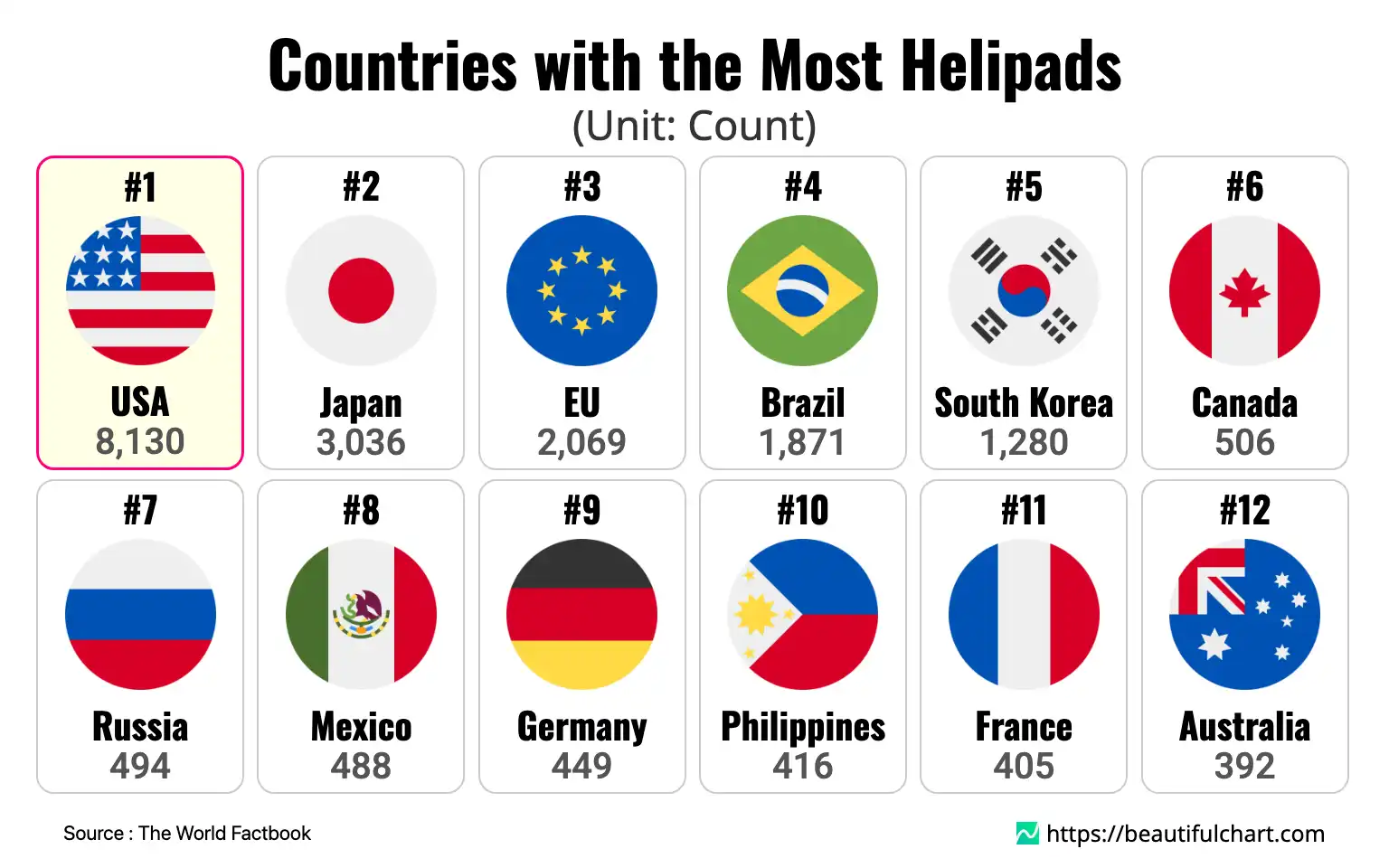The United States holds a commanding lead in global heliport infrastructure, with over 8,100 registered landing sites. This figure is more than double that of the second-ranked country, Japan, which has approximately 3,000 heliports. The data highlights a significant concentration of helicopter landing facilities in a few key nations, with the European Union, Brazil, and South Korea rounding out the top five.

A heliport is a designated area, either on land, on a building, or on a structure, used for the landing and takeoff of helicopters. It includes facilities for refueling, maintenance, and housing of helicopters. Unlike an airport, a heliport is specifically designed for vertical takeoff and landing (VTOL) aircraft.
The global distribution of helicopter landing pads reveals a landscape dominated by a handful of nations, reflecting a combination of economic strength, geographical necessity, and advanced infrastructure. The concentration of these facilities is a strong indicator of a country's capacity for rapid transport, emergency response, and specialized industrial operations.
The Global Landscape of Helicopter Infrastructure
The United States possesses an unparalleled network of heliports, numbering over 8,100. This extensive infrastructure supports a wide array of services, including emergency medical transport (EMS), law enforcement, disaster relief, and corporate travel. The sheer size of the country, coupled with its economic might, drives the demand for point-to-point air travel that helicopters provide, bypassing ground congestion in dense urban centers and connecting remote locations. This vast network facilitates critical operations where speed and accessibility are paramount.
Following the U.S., Japan's infrastructure with over 3,000 heliports is notable. Its mountainous terrain and high susceptibility to natural disasters like earthquakes and tsunamis make helicopters an indispensable tool for rescue and logistics. In a country where ground transportation can be easily disrupted, vertical lift capability is a matter of national resilience. Similarly, Brazil's high number of heliports is tied to its vast and often challenging geography, including the Amazon rainforest and sprawling cities. Helicopters are essential for accessing remote industrial sites, particularly for the oil and gas industry, as well as for security and executive transport in major urban areas like São Paulo and Rio de Janeiro.
Economic and Geographic Drivers
The number of heliports in a nation is closely linked to its economic development and specific geographical characteristics. Developed nations with large economies naturally have more resources to invest in aviation infrastructure. Corporate headquarters, major hospitals, and media outlets often operate their own helicopters, requiring dedicated landing facilities. The European Union's collective count of over 2,000 heliports underscores the economic integration and high level of development across the continent.
In contrast, countries with vast, sparsely populated territories or difficult terrain, such as Canada and Australia, also rely heavily on helicopters for connecting remote communities, mining operations, and environmental monitoring. South Korea's position in the top five, with over 1,200 heliports, highlights a different driver: high population density and a technologically advanced, export-oriented economy. In such a compact and dynamic environment, helicopters offer a crucial advantage for time-sensitive business and public service operations. The strategic importance of this infrastructure is also amplified by its geopolitical context, requiring robust military and civil defense capabilities.
Key Takeaways
Global Distribution and Concentration
- The United States has the most heliports by a significant margin, with more than twice the number of the next country.
- The top five countries—USA, Japan, EU, Brazil, and South Korea—account for a substantial portion of the world's total heliports.
- There is a wide disparity in heliport numbers globally, with many nations having fewer than 100 facilities.
Economic and Strategic Implications
- A high number of heliports often correlates with a nation's economic strength and level of industrialization.
- Geographic factors, such as mountainous terrain or vast remote areas, drive the need for helicopter infrastructure for accessibility and emergency services.
- Heliports are critical assets for a variety of sectors, including healthcare, law enforcement, disaster relief, and corporate logistics.
Top Ranking
#1 USA 8,130
The United States' top ranking is a reflection of its vast territory, large economy, and extensive use of helicopters in various sectors. Heliports are integral to the nation's infrastructure, supporting critical services such as emergency medical transport, law enforcement, firefighting, and disaster relief. Furthermore, the corporate sector heavily relies on helicopters for executive transport to bypass traffic in congested metropolitan areas. The high number also indicates a robust general aviation culture and significant private ownership of helicopters.
#2 Japan 3,036
Japan's second-place position is largely driven by its geography and focus on disaster preparedness. As a mountainous archipelago prone to earthquakes and tsunamis, helicopters are essential for search and rescue, medical evacuations, and transporting supplies when ground infrastructure is compromised. Its dense urban centers also utilize heliports for business travel and emergency access to skyscrapers, making vertical lift capability a crucial component of both national security and urban planning.
#3 EU 2,069
The European Union's collective total of over 2,000 heliports reflects the continent's advanced economies and high degree of integration. These facilities support a wide range of activities, from offshore oil and gas operations in the North Sea to tourism in the Alps and emergency medical services across member states. The strong regulatory framework and collaborative aviation safety standards within the EU facilitate a thriving helicopter industry, contributing to the high number of registered landing sites.
#4 Brazil 1,871
Brazil's extensive number of heliports is a response to its immense landmass and unique logistical challenges. The country is home to one of the world's largest corporate helicopter fleets, particularly in São Paulo, where wealthy individuals and executives use them to navigate the city's chronic traffic congestion. Additionally, helicopters are vital for accessing remote areas of the Amazon rainforest and supporting the country's significant oil and gas, mining, and agricultural industries.
#5 South Korea 1,280
South Korea's ranking is notable for a country of its size, highlighting its high-tech, densely populated, and dynamic environment. Heliports are crucial for corporate and government transport in the bustling Seoul metropolitan area. They also play a vital role in national defense and emergency services, given the country's geopolitical situation. The infrastructure supports a modern economy where speed and efficiency are paramount, making helicopter travel a valuable asset for both civil and military operations.
| Rank | Name | Indicator |
|---|---|---|
1 | 8,130 | |
2 | 3,036 | |
3 | 2,069 | |
4 | 1,871 | |
5 | 1,280 | |
6 | 506 | |
7 | 494 | |
8 | 488 | |
9 | 449 | |
10 | 416 | |
11 | 405 | |
12 | 392 | |
13 | 289 | |
14 | 240 | |
15 | 204 | |
16 | 194 | |
17 | 163 | |
18 | 162 | |
19 | 148 | |
20 | 142 |





